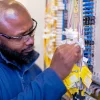Guernsey ISP Sure Prep 300Gbps Upgrade of Subsea Fibre Network
The incumbent broadband, 4G mobile and phone provider on the English Channel Island of Guernsey, Sure, has announced a major 5-year plan to invest several million pounds in order to upgrade their sub-sea fibre optic links with the United Kingdom. This could increase network capacity to 300Gbps (Gigabits per second).
At present most fixed broadband connections on the island are delivered by a Fibre-to-the-Cabinet (FTTC / VDSL) network that is capable of speeds up to 100Mbps, although this is expected to be improved with the future introduction of Very High bit rate Digital Subscriber Line (VHDSL) technology. Some Fibre-to-the-Premises (FTTP) infrastructure is also present on parts of the island.
Last year the States of Guernsey (Government) set out a new strategy to help bring FTTC/P to business districts, support the rollout of ultrafast 5G mobile technology and ensure that 85% of homes can access broadband speeds of up to 100Mbps (public money was proposed to help fix the final 15% but the details of this remain unclear).
Advertisement
Suffice to say that all of the above, when combined with rising data demands from local consumers, means that operators like Sure and JT on Guernsey will need more capacity. Both JT and Sure already have multiple links on the island, most of which connect to the UK and one goes back through Jersey and then on to France (INGRID / Channel Islands Electricity Grid).
Guernsey’s Subsea Fibre Links
UK-Channel Islands-7 / CI-7 (Owner: Sure, BT , JT) – 6 fibre pairs
Channel Islands-9 Liberty Submarine Cable (Owner: JT) – 4 fibre pairs
HUGO – High-capacity Undersea Guernsey Optical-fibre (Owner: Sure, Vodafone) – 2 fibre pairs
Guernsey-Jersey-4 / CI-4 (Owner: Sure, BT , JT) – 6 fibre pairs
INGRID / CEIG (Owner: BT / Sure / JEC) – 24 fibre pairs
NOTE: Ownership information can change over time, so the above might not be 100% accurate.
We should point out that both CI-4 and CI-7 have an estimated lifespan of 25 years and they’ll actually be reaching the end of their predicted life this year, which is important because Sure doesn’t say precisely which of their subsea cables are going to be upgraded to deliver this 300% capacity increase or how. Sure could conceivably extend the lifespan of those cables by adding new repeaters to tackle loss, but they might also build a new cable.
Ian Kelly, Sure CEO, said (Guernsey Press):
“The importance of our subsea infrastructure really can’t be overstated. Guernsey has been winning business on the world stage as a direct result of our network resilience and of course it keeps all of us connected in our daily lives. It is the unseen foundation that enables and secures connectivity for businesses, in our homes and when mobile.
We’re carrying out this upgrade work, which is a significant multi-million pound investment, to reinforce the quality of the infrastructure and ensure that our network continues to be the most resilient in the Channel Islands. The digital future and this investment are aligned with the States of Guernsey’s ambitious telecoms strategy as we work together to secure the island’s continued prosperity and success.”
You can read the local Government’s Digital Strategy (PDF) for a bit more background to why Sure are making this change. Sure also appear to be considering the idea of using their future 5G network to reach homes with ultrafast broadband, rather than further extending their fixed line FTTC/P.
Sure currently owns 100% of fixed line services to consumer households and has the ability to connect most businesses and Government departments to fibreSure, which has over 400km of fibre in the ground and typically spends in the region of £1m a year on extending the reach of this network.
Advertisement
Mark is a professional technology writer, IT consultant and computer engineer from Dorset (England), he also founded ISPreview in 1999 and enjoys analysing the latest telecoms and broadband developments. Find me on X (Twitter), Mastodon, Facebook, BlueSky, Threads.net and Linkedin.
« 557 Premises in Braintree Get UK ISP Gigaclear’s 1Gbps Broadband
















































Comments are closed